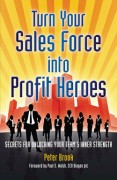Author Archives: Infinite Ideas
How a published book can help promote a consultancy
10 July 2013 by Infinite Ideas in Book publishing
by Peter Brook, author of Turn your sales force into profit heroes.
They say everyone has at least one book in them and until recent years I had a long-held ambition to become a published author. After years in the FMCG industry, I’d gained a huge amount of insight into why some product launches worked, but why many failed. I’d worked with top brands and what I learnt was this – invariably, exceptional performance comes from having sales people who execute the basics brilliantly and, more importantly, are passionate about what they’re doing.
Determined to get my insights into print, I met with the Infinite Ideas team and was impressed by what they told me and their plans to market the book and my consulting business. All I had to do was write the damn thing. So I set aside some time, locking myself away in rural Norfolk to concentrate on my magnum opus. I quickly realised that I needed some support and I received that in the shape of a very supportive co-writer. He helped me structure the book properly (it was far harder than I thought to get my knowledge down on the page) and the net result was a powerful manuscript that I delightedly handed over to my publishers after some six months of writing.
It was an exciting period, seeing the book become real. Infinite Ideas gave a full input into the book’s overall design and in March 09 my book was launched.
Now, it’s a tough market out there as every publisher will tell you. Bookshops are not as supportive of new authors as they used to be, but it was a fantastic buzz to walk into bigger stores and see my book on the shelf. But having a book published is not just about book stores these days. It’s about media coverage and Infinite Ideas secured me interviews and articles in the trade press. A professionally published book gets you noticed and gives you a degree of authority – in effect it can turn you very quickly into an industry expert.
 But guess what? As a result of someone buying my book at Heathrow airport I picked up a substantial piece of consulting business within a month of publication. The book has been successful around the world; some big FMCG companies have bought multiple copies for their sales teams, all of which helps to get my consulting services known globally.
But guess what? As a result of someone buying my book at Heathrow airport I picked up a substantial piece of consulting business within a month of publication. The book has been successful around the world; some big FMCG companies have bought multiple copies for their sales teams, all of which helps to get my consulting services known globally.
Sure, it’s available as an e-book too on consumer and B2B platforms and that’s given me valuable exposure, but I am convinced that a physical printed book (even in this digitally thirsty world) is vitally important. Books are valued, they rarely get thrown away and my book sitting in my clients’ offices means my profile remains high.
 Publishing Turn your sales force into profit heroes really helped launch my consulting business and promote me as an industry expert, an authority. I’d heartily recommend that if you are passionate about what you do, you consider the value of becoming a published author.
Publishing Turn your sales force into profit heroes really helped launch my consulting business and promote me as an industry expert, an authority. I’d heartily recommend that if you are passionate about what you do, you consider the value of becoming a published author.
Two new gluten-free books
7 May 2013 by Infinite Ideas in Lifestyle
Food and diet writer Kate Santon has written two new gluten-free ebooks, which Infinite Ideas are publishing this month. The books are called Living gluten-free and Gluten-free kids. They’re handy, quick guides if you suffer from coeliac disease or know someone who does.
Living gluten-free by Kate Stanton
Adopting a gluten-free diet is essential if you suffer from coeliac disease. It can solve all sorts of health problems and can be straightforward once you’ve learned a few simple rules of thumb. If you get it right your general health will improve and there are significant energy benefits since as well as avoiding the gluten that makes you unwell you’ll probably be cooking a lot more and avoiding processed foods. To start with you need to understand your condition and Living gluten-free will help you do just that. The book also contains plenty of tips on sourcing and using helpful unfamiliar ingredients, spotting hidden gluten in common grocery items, finding good stuff where you might not expect it (such as supermarket ‘basics’ ranges), and some good but brief recipe ideas as well as golden rules for eating out and entertaining.
Gluten-free kids by Kate Stanton
A gluten-free diet requires real commitment and is a long-term lifestyle change that will affect the whole family. However, it will become much easier with time and the help of the ideas in this little book. Gluten-free kids covers what exactly coeliac disease is and how it affects your child and gives you tips on helping your child understand their condition. The book also explains the importance of making sure that everyone from Grandma to the headteacher is aware of the diagnosis and its implications, suggests ways to cope with potential pitfalls such as peer pressure and teenage rebellion and shows you how to ensure that parties, holidays and family meals remain a pleasure not a chore. By following the advice in this book you’ll avoid the stress and make gluten-free eating a natural part of your family’s life.
What are you looking at?
1 May 2013 by Infinite Ideas in Lifestyle
It’s rare, but when used effectively second-person narration can knock the reader’s socks off. Anybody who read Fighting Fantasy books when they were younger will know the second-person narrative style intimately: ‘You enter the cavern and see a werewolf dead ahead. What will you do?’ This viewpoint is something of an outsider in narrative theory, but when used well it can have a profound effect on your reader. It is ‘you’ at the centre of things, ‘you’ who is now implicated in the story, for better or for worse. Of course, the second person can also be used to express intimacy and companionship, as this book hopefully demonstrates!
 Self-help books aside, you need a good reason to use second-person narrative style in your work. Think about what you are trying to achieve – do you want the reader to feel like a character? Do you want to boss them around, to force them into a certain frame of thought? Do you want to convey the sense of a shared, intimate experience? Or do you want to make the reader complicit in whatever is going on in the text? One striking novel that uses the second person for precisely this last effect is Iain Banks’ Complicity. Several of the chapters involve ‘you’ as the protagonist. Although it’s not immediately clear what you are doing, you soon realise that ‘you’ are a serial killer, and you’re forced to witness – commit, even – several horrific murders from a very intimate, and unsettling, viewpoint.
Self-help books aside, you need a good reason to use second-person narrative style in your work. Think about what you are trying to achieve – do you want the reader to feel like a character? Do you want to boss them around, to force them into a certain frame of thought? Do you want to convey the sense of a shared, intimate experience? Or do you want to make the reader complicit in whatever is going on in the text? One striking novel that uses the second person for precisely this last effect is Iain Banks’ Complicity. Several of the chapters involve ‘you’ as the protagonist. Although it’s not immediately clear what you are doing, you soon realise that ‘you’ are a serial killer, and you’re forced to witness – commit, even – several horrific murders from a very intimate, and unsettling, viewpoint.
This feels like you’re behind the eyes of a killer. Whereas with a more conventional form of narrative you could distance yourself from the events, here you literally are complicit with them. Like it or not, you become the character and have to sit with a puppet-like empathy as you maraud your way through your victims. On a less disturbing level, the second person works to make reading the text as strange an experience as possible. People aren’t generally used to being addressed in a work of fiction. By doing so, you are creating an intimate bond with each reader, allowing them to take the front seat in your imaginary world. Used well, and your work will really stand out from the crowd. Used without good reason, though, or written sloppily and all it will do is confuse and alienate people.
Writing an entire text in the second person is an ambitious, and some might say foolhardy, undertaking, but there’s nothing to stop you addressing the reader every now and again. Back in the good old days when the novel was a relatively new phenomenon, narrators often made conversational asides to the reader. And whilst not as common today, the narrator can still throw in an occasional comment or two directed at ‘you’, just to make sure you’re still awake.
If you’re writing in a first-person viewpoint, especially one confessional in tone, this seems perfectly normal – just look at D. B. C. Pierre’s Vernon God Little. If you’re writing with a third-person narrator, however, addressing your readers explicitly may direct their attention away from the events of the text and towards its construction. All of a sudden, this disembodied, neutral observer has developed an opinion, and is talking to you like you’re its best friend.
If you want an example of how second-person narration is used to excellent effect, read Italo Calvino’s If On a Winter’s Night a Traveller. Here, the narrator begins the tale by instructing you, the reader, to lie down, relax with the book, and tell your friends not to interrupt your reading – almost like an instruction manual for enjoying the book. It alerts you to the novel’s artifice, but it also creates a welcome sense of intimacy between the narrator and the reader.
How To Lose Weight
22 April 2013 by Infinite Ideas in Lifestyle
Master the art of goal-setting to turn your dream of losing weight into reality. Most of us don’t do it, but planning really works!
A well-known study of a group of US students in the 1950s found that only three per cent of the graduates wrote a set of goals for their lives.
A follow-up survey some twenty years later discovered that the goal-setting students were worth more financially than the other 97% put together. You may say, well, life’s not all about money. No, it’s not – but the goal setters were also healthier and happier in their relationships than the others.
Goal-setting is as relevant to weight loss as it is to life plans, but it’s not always as straightforward as it seems. Simply saying ‘I want to lose weight’ may well be true and seem to be a goal, but it won’t get you very far. Why? Because goals need to be SMART: that’s Specific, Measurable, Attainable, Realistic and Time-framed. Put simply, by analysing how to reach your end goal, you increase your chances of achieving it.
OK, let’s do it. Get some paper and a pen and start writing.
 Be Specific – Write down how much weight you want to lose. Is there also a particular reason you want to lose this amount, for a special occasion, or is it for health reasons? Perhaps you’ve always been overweight and really want to do something about it. It’s important to think around the reasons you want to slim down as part of the ‘why’ of your goal. Once it’s clear in your head, you’ll be in control and focused.
Be Specific – Write down how much weight you want to lose. Is there also a particular reason you want to lose this amount, for a special occasion, or is it for health reasons? Perhaps you’ve always been overweight and really want to do something about it. It’s important to think around the reasons you want to slim down as part of the ‘why’ of your goal. Once it’s clear in your head, you’ll be in control and focused.
Measurable – How will you measure you weight loss? By weighing yourself regularly or by dropping a clothing size? Or will you just go by the way you look or feel? How often will you take stock of your achievements? There’s no right or wrong answer here – it’s just about what works for you.
Attainable – Question yourself as to whether this goal is really what you want. You could think about it in terms of your commitment and enthusiasm. If you’re not 100% happy about your goal, maybe you need to revisit the specifics to review whether it is too ambitious or too challenging for you to feel confident about it. A goal does have to stretch you, but if it seems unattainable you’ll become downhearted pretty quickly. Of course, we all have different definitions of what’s attainable and what isn’t – it depends on factors such as your personality, confidence and experience.
Realistic – With the best will in the world, if you are 165 cm (5 ft 5 in) and pear-shaped, no diet is going to turn you into Aussie model/actress/business woman Elle McPherson – especially if you’re a man! Make sure your goal is realistic. Think about your goal in terms of being the best you can be.
Time-framed – A time frame keeps your goal on track. Set a start point, such as ‘I will start my healthy eating weight loss plan on Thursday’ and give yourself an end time too, such as ‘I will lose five kilos by my summer holiday.’ I think it also makes sense to include a couple of time frames in your overall goal representing short and longer term achievements. This helps with motivation. So you could add ‘I will start exercising three times a week on Mondays, Wednesdays and Saturdays from next week’ and so on. Use positive goal-getting language when writing down what you’re going to achieve. There’s no room here for ‘might’ and ‘ought to’.
By now your goal should be looking so clear that you can reach out and touch it. I hope you feel all revved up and ready to go. One other thing: do remember to congratulate yourself every step of the way, whether it is with little (non-fattening) rewards or simply a mental pat on the back.
How To Declutter A House
1 April 2013 by Infinite Ideas in Lifestyle
Decluttering is the new black. Whether you want to make extra space or simply clear up your home, get set for a brutal experience.
There is a way of tackling tidying that lacks commitment. It involves tucking papers in drawers, putting magazines back in the rack and working on the assumption that ‘I might use it one day’.
Stop right now, thank you very much, in the words of the immortal Spice Girls. If you are going to declutter you need to approach it with dedication and verve and most importantly, with a lack of sentimentality.
 Pick a room – any room – and sit in the middle. What you are about to do is remove roughly one-quarter of the contents in that space. That’s your target. (And that’s just for starters. Once you have performed your initial declutter, if you are really serious about it I want you to go back a week later and repeat the process.) In the kitchen: you are chucking out unused spices, old tins, battered bakeware, chipped crockery, fraying table linen, knackered saucepans and unused gadgets (bread makers and juicers being chief culprits). In the lounge: you are getting rid of books on the bookshelf (that’s where the sentimental bit comes in for me; I hate getting rid of books), China ornaments that were dodgy holiday mementoes or suspect gifts, dried flower arrangements, worn out cushions and old CDs. In the bedroom: you are looking to give many, many items of clothing to the charity shop. If you keep your bed linen in there, how many sets do you realistically need? If you’ve mislaid one of a matching pair of pillowcases chuck the odd one out – if you take it downstairs to the kitchen to cut up and use as cleaning cloths you are only adding to the clutter down there, so chuck it.
Pick a room – any room – and sit in the middle. What you are about to do is remove roughly one-quarter of the contents in that space. That’s your target. (And that’s just for starters. Once you have performed your initial declutter, if you are really serious about it I want you to go back a week later and repeat the process.) In the kitchen: you are chucking out unused spices, old tins, battered bakeware, chipped crockery, fraying table linen, knackered saucepans and unused gadgets (bread makers and juicers being chief culprits). In the lounge: you are getting rid of books on the bookshelf (that’s where the sentimental bit comes in for me; I hate getting rid of books), China ornaments that were dodgy holiday mementoes or suspect gifts, dried flower arrangements, worn out cushions and old CDs. In the bedroom: you are looking to give many, many items of clothing to the charity shop. If you keep your bed linen in there, how many sets do you realistically need? If you’ve mislaid one of a matching pair of pillowcases chuck the odd one out – if you take it downstairs to the kitchen to cut up and use as cleaning cloths you are only adding to the clutter down there, so chuck it.
In the bathroom: it’s time to dispose of old make-up, old medicines, half-used body lotions and potions and towels that were stained by your last hair-dyeing experiment. It’s all very well thinking ‘I’ll use that at the beach’, but when was the last time you remembered to take a spare towel with you? It’s a process that is loosely based on the William Morris principle ‘Have nothing in your houses that you do not know to be useful, or believe to be beautiful.’ And it makes absolute sense. Most of our clutter is just a home for dust and dirt. So here’s how to approach the job. Start in the corner furthest away from the door. If there’s a rug on the floor or a cushion that needs to go, take it out of the room and put it in a pile outside the door. If there’s a cupboard in the corner, open the door and, starting from the top, take out everything that’s on the shelf. For each item ask yourself when was the last time that you looked at it, read it, used it or even thought about it. If you can’t remember any of the above then take it out of the room and add it to the pile. If the cupboard is not sectioned off, bring in some new storage systems: box files for papers, garments bags for clothes, etc.
I should mention at this point that it might be worth having a bottle chilling in the fridge, because you will need an incentive after and hour of two of doing this. Also, in the same way that people jog to pacey music or work out to funk, make sure that you are listening to something inspirational. I mix up a bit of Barry White, some Stone Roses, very early Michael Jackson and a bit of Bruce Springsteen. It all gets me moving one way or another.
Don’t give up when you get bored: the aim is to clear the excess baggage in one sitting. You have to look on it as a job that needs completing before you are allowed that glass of wine, not reach for the bottle when you are halfway through. Take everything that you’ve removed and recycle it in the appropriate way.
Approach decluttering with the determination of a pitbull and you’ll reap the rewards in terms of tidiness, cleanliness and lots of lovely extra space.
Reducing Your Carbon Footprint
1 March 2013 by Infinite Ideas in Lifestyle
‘Carbon footprint’ is the buzzword when it comes to living a greener life. We all have one we shouldn’t, and the fastest way to reduce it is to make your home a greener place.
Your home is probably your main source of pollution. Hard to accept, isn’t it? But once you turn eco-spy, you’ll find ways of making it green.
Everyone’s heard the saying ‘think global, act local.’ Well, your own home is about as local as it gets. And the way you live at home can have worldwide implications.
Let’s start with the all-important carbon footprint that everyone’s talking about at the moment. The main thing about it is, we don’t want one! Or at least, we want a small one, so in this case, size does matter.
 Your carbon footprint is the imprint your activities leave on the environment in terms of the amount of greenhouse gases produced, measured in units of carbon dioxide. Everything you do at home, from the way you dispose of waste to the temperature on your thermostat, has an impact on the size of your carbon footprint.
Your carbon footprint is the imprint your activities leave on the environment in terms of the amount of greenhouse gases produced, measured in units of carbon dioxide. Everything you do at home, from the way you dispose of waste to the temperature on your thermostat, has an impact on the size of your carbon footprint.
And man-made CO2 is one of the biggest contributors to global warming. The net result of this climate change is sadly not going to be lovely hot summers and pleasant, mild winters. Instead, glaciers and sea ice would melt, sea levels would rise, and coastal areas would flood. Inland areas would become hotter and drier, and lakes and rivers could dry up. There would be more droughts, making it hard to grow crops, and some plants and animals might become extinct because of the heat. Hurricanes, tornadoes and other storms may get more common.
Overall, the cost to society, the environment, our health and the economy is likely to far outweigh any benefits.
But we can all help contain global warming, starting with minimising your footprint – and there’s no time like the present. We’ll be looking at ways of reducing your carbon footprint throughout this book, but there are things you can do today, in your home, to reduce your contribution to global warming. Best of all, they should not cost you a penny, and in the long term will save you cash.
- Sign up to a green energy supplier.
- Turn down the central and water heating slightly.
- Use dishwashers, washing machines and driers to full capacity, or use half-load programmes.
- Don’t leave appliances on standby.
- Hang out the washing to dry rather than tumble-drying.
- Fit energy-saving light bulbs.
- Insulate your hot water tank, your loft and your walls.
- Recycle and reuse.
- Save water by harvesting rainwater, reusing ‘grey’ water and cutting down on hosing.
Apart from global warming, general pollution threatens our health, crops and wildlife. You can help reduce pollution with all of the above steps. As a bonus, you could also switch to organic food, and use fewer chemicals around the home.
Once you’ve got the ball rolling, make sure your whole household is involved. Get teenagers to switch off gadgets and lights when not in use; explain to the kids how recycling works and ask them to help you sort your waste into the right bins; persuade Granny to share her make-do-and-mend tips and Grandad his compost recipe. Encourage the whole family to cut back on water usage, for instance by not leaving taps running; and get everyone used to having the house slightly cooler. And just watch your carbon footprint shrink!
